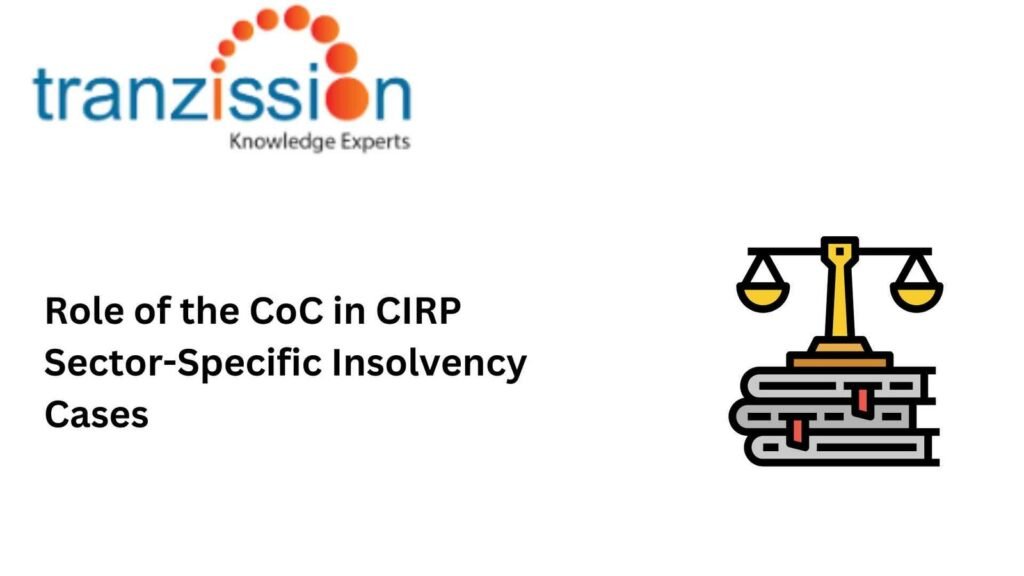
Role of the CoC in CIRP Sector-Specific Insolvency Cases

Table of Contents
Sector-specific insolvency cases are needed to address the unique characteristics of different industries, aspects that the Insolvency and Bankruptcy Code, 2016 (IBC) may not address. The Committee of Creditors’ (CoC) decision is crucial in forming the resolution plans that either revive the corporate debtor is liquidate them. Thereby, the CoC in CIRP decisions on sector-specific regulations are currently limited, meaning that there are hindrances in maximising the recovery rates and efficiently resolving distressed businesses within a particular sector.
Role of the CoC in CIRP
In a corporate insolvency resolution process (CIRP), the CoC in CIRP acts as the primary decision-making body and has significant power to oversee the entire process. To understand the role of the CoC in CIRP in more detail, read the following:
What is the CoC?
The CoC is constituted by the interim resolution professional (IRP) after the collation of claims received against the corporate debtor and determining the financial position of the corporate debtor. As per section 21(2) of the IBC, the CoC in CIRP comprises of the financial creditors of the corporate debtor. Their responsibilities during the corporate insolvency resolution process include approving or disapproving the resolution plans, appointing or replacing the resolution professional, protecting the interest of the creditors, and maximising the value of the debtor’s assets to distribute among creditors.
Commercial Wisdom of the CoC:
The commercial wisdom of the CoC states that the CoC in CIRP has the authority to make business decisions without the court’s interference unless such decisions are arbitrary or unreasonable. The Supreme Court in the Essar Steel case held that the CoC’s commercial wisdom is paramount and cannot be questioned. The court also upheld the final decision of the CoC in the resolution plans and the primacy of financial creditors in the distribution of funds.
Read more : Understanding the Interplay between Insolvency Law and Contract Law
Key Challenges Faced by the CoC in CIRP
Analysing the current insolvency framework in India, there are challenges to the commercial wisdom of the CoC in CIRP, especially in sector-specific regulations, like procedural delays, difficulties in consensus building, and unreasonable decisions:
Inclusivity and Composition Issues:
Section 21 states that the CoC comprises of the financial creditors, thereby there is an excursion of key stakeholders, such as operational creditors, employees, etc. Under this section, operational creditors can form part of the CoC only if the corporate debtor has no financial creditors or the financial creditors are related parties of the debtor. Further, in real estate cases, land authorities are also important stakeholders, which are excluded from the CoC under IBC. The implications of limited representation affect the outcome of CIRP outcomes and reduce stakeholder confidence.
Decision-Making and Delays:
The composition of the CoC ultimately makes it difficult to achieve consensus in their meetings. The diversified interests of the creditors lead to disagreements, further delaying the resolution process. For instance, deadlocks created because of conflicting interests of stakeholders, end in delayed decision-making and erosion of the asset value. Therefore, the entire insolvency process is adversely impacted due to the non-participation of all stakeholders in the CoC meetings.
Lack of Sector-Specific Expertise:
The CoC members often lack the necessary sectoral knowledge to evaluate complex businesses, particularly in infrastructure and telecom industries. As a consequence, the members may often make poor decisions in forming the resolution plans, plans that may not be approved by the National Company Law Tribunal (NCLT). This delays the resolution process and ends in the undervaluation of the corporate debtor’s assets.
Read more : Implications of Public Policy in the Insolvency Process
Concerns Over Transparency:
There are issues with the transparency of the CoC’s operations, claiming that their meetings lack disclosure regarding the rationale behind their choices. The conflicts of interest among creditors potentially lead to unfair outcomes for certain stakeholders.
Evolving Framework and Legal Developments
Through judicial decisions and recommendations, there have been legal developments to the IBC:
Judicial and Regulatory Changes Impacting CoC Operations:
The recent development includes land authorities in the CoC for real estate insolvency cases. In K. Sashidhar Vs. Indian Overseas Bank has listed certain cases where judicial intervention may be permissible, such as the CoC decision violates the IBC provisions, may contain material irregularities or fraud, or fails to comply with the rules established by the Insolvency and Bankruptcy Board of India (IBBI).
Recommendations from IBBI and IIIPI Reports:
The Report of the Indian Institute of Insolvency Professionals of ICAI (IIPI) suggested for the CoC to disclose all the relevant information which is crucial to the resolution professional understanding the corporate debtor, the CoC members should prove that their decisions are clear and are done to revive the debtor, and the approval of resolution plans balances the interests of all creditors. The IBBI recommends that there be inclusivity in the formation of CoC to address sector-specific issues.
Recommendations and Best Practices for CoC Operations:
Insolvency professionals and IP aspirants should ensure a more inclusive CoC by involving key stakeholders like operational creditors and regulators in decision-making. The IBBI needs to promote training and capacity-building initiatives for CoC members to improve sectoral expertise.
Case Studies and Real-World Examples
In the Essar Steel Case, the Supreme Court held by a majority that the CoC, in its commercial wisdom, had decided that the payment of debts due to the secured financial creditors would be made according to the value of the security provided by the corporate debtor to such financial creditors. The Swiss Ribbons Case focused on the differential treatment of operational creditors and financial creditors in the IBC. The court upheld the IBC’s constitutionality and emphasises the differences between the two types of creditors. The K. Sashidhar v. Indian Overseas Bank upheld the principle of commercial wisdom while stating that the judicial review of CoC decisions is limited to checking for procedural irregularities or fraud, not simply disagreeing with their commercial decisions.
Conclusion
Certain industries like real estate, shipping, and energy require regulatory frameworks, and market conditions that require specialised insolvency procedures to handle liquidation or restructuring effectively. In sector-specific insolvency cases, the CoC plays a pivotal role in making critical decisions. The CoC is the primary decision-making body and drives the resolution process, making it vital to address the challenges addressing inclusivity, transparency, and expertise within the CoC. Therefore, the CoC members and their knowledge are important to ensure a fair and efficient outcome for all stakeholders involved in the resolution process.





